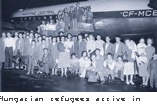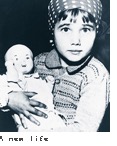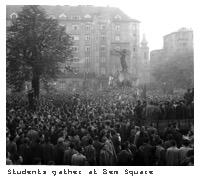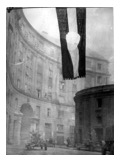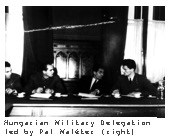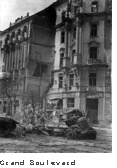CHRONOLOGY OF THE HUNGARIAN
REVOLUTION 1956
The Prelude
1948 – 1953
The post war legacy
- Soviet occupation troops remain in Hungary with nominal agreement by the Hungarian government despite the 1957 Peace Treaty requiring their withdrawal
- A Stalinist style communist dictatorship led by Mátyás Rákosi, 1st secretary of the Hungarian Workers Party (HWP), replaces the fledgling 1946 multi-party government
- Any opposition including members of the HWP is rigorously oppressed
- Communists such as László Rajk are tried and executed
- Emphasis is placed on transforming Hungary into a heavy industrial state with dire consequences for the population
- There are deplorable living conditions, lack of food and goods, inadequate housing and low wages
- Agricultural production was stifled by collectivization
- Students were dissatisfied by academic conditions and entrance requirements
March 1953
The Stalin period comes to a close
- On Mar 4 1953 Joseph Stalin dies
- This Initiates a process of change in Soviet policy
- Khrushchev begins a process of “de-Stalinization”

May 1953
Imre Nagy is appointed Prime Minister
- This is secretly initiated by Moscow as part of the de-Stalinization which they believe should extend to the Soviet sphere of influence
- The change is primarily intended to forestall the incipient crises as a result of the economic chaos which has brought Hungary to the point of economic collapse
- Although he is required to support the new Prime Minister by orders from Moscow, Mátyás Rákosi is strongly opposed to the change
- Rákosi, who still has control of the Party, begins the process of undermining Nagy
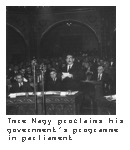
July 1953
Nagy embarks on the “New Course”
- Change in economic priorities
- Less emphasis on heavy industry
- Reversal of forced agricultural collectivisation
- Partial amnesty for political prisoners
- Reduction of State Security Office (ÁVH) power
- End to internment and internal exile processes
December 1954
Nagy programme destined for failure
- There is no way to obtain quick results
- Rákosi continues his behind the scenes interference with Nagy policies
- The Nagy government is viewed with growing disfavour in Moscow
- By late 1954 his ouster has been initiated
March 1955
Nagy resigns
- On recommendation by Rákosi, András Hegedüs is appointed Prime Minister
- Nagy is removed from the Political Committee and Central Committee
May 1955
The Warsaw Pact is created
- Signed by Hegedüs
- Provides the rationale for Soviet troops stationed in Hungary that were to withdraw according to the 1947 Peace Treaty
February 1956
20th Congress of the Communist Party of the Soviet Union
- Formalizes the process of de-Stalinization
- Pressure on Hungarian Party and Rákosi to investigate illegalities of the Stalin era
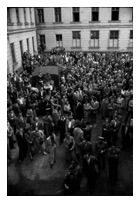
March 1955 to October 1956
Formation of the Petöfi Circles
- Founded in March 1953 as an adjunct to the Union of Working Youth
- Enjoys increasing support in its activities in opposition to the Rákosi system
- Holds large press debate on June 27, 1956
June 28, 1956
Poznan Worker’s uprising in Poland
- 1000 workers demonstrate for improved working conditions and free elections
- Security forces use arms to break up the crowds
- Results in >100 deaths, hundreds of injuries and arrests
July 21, 1956
Rákosi steps back
- Due to mounting pressure Mátyás Rákosi resigns as first secretary of the Hungarian Worker’s Party
- Ernö Gerö is appointed as his replacement

October 6, 1956
László Rajk reburied
- László Rajk, György Pálffy, Tibor Szõnyi and András Szalai; victims of the Stalinist show trials of 1948, are reburied at Budapest’s Kerepesi út cemetery
- After the funeral, student demonstrations take place
From Demonstration to Armed Uprising
October 20-22, 1956
Poland sets the signals
- Gomulka is elected as 1st Secretary of Polish United Worker’s Party
- He openly criticizes the mistakes made in the past
- Hungarian students initiate demonstrations in solidarity with Poland
October 22, 1956
Students draft list of 16 demands
- Students of Budapest University meet on the night of October 22.
- They draft a list of 16 demands for the government
October 23rd, 1956

Student Demonstrations
- In the afternoon, large crowds of students demonstrate at Bem Square and Petöfi Square
- The list of 16 demands is read out
- We demand the immediate evacuation of all Soviet troops, in conformity with the provision of the Treaty of Peace.
- We demand the election by secret ballot of all Party members from top to bottom, and of new officers for the lower, middle and upper echelons of the Hungarian Workers Party. These officers shall convoke a Party Congress as early as possible in order to elect a Central Committee.
- A new Government must be constituted under the direction of Comrade Imre Nagy: all the criminal leaders of the Stalin-Rákosi era must be immediately relieved of their duties.
- We demand a public enquiry into the criminal activities of Mihály Farkas and his accomplices. Mátyás Rákosi, who is the person most responsible for all crimes of the recent past as well as for the ruin of our country, must be brought back to Hungary for trial before a people’s tribunal.
- We demand that general elections, by universal, secret ballot, be held throughout the country to elect a new National Assembly, with all political parties participating. We demand that the right of workers to strike be recognised.
- We demand revision and re-adjustment of Hungarian-Soviet and Hungarian-Yugoslav relations in the fields of politics, economics and cultural affairs, on a basis of complete political and economic equality, and of non-interference in the internal affairs of one by the other.
- We demand the complete reorganisation of Hungary’s economic life under the direction of specialists. The entire economic system, based on a system of planning, must be re-examined in the light of conditions in Hungary and in the vital interest of the Hungarian people.
- Our foreign trade agreements and the exact total of reparations that can never be paid must be made public. We demand precise and exact information on the uranium deposits in our country, on their exploitation and on the concessions accorded the Russians in this area. We demand that Hungary have the right to sell her uranium freely at world market prices to obtain hard currency.
- We demand complete revision of the norms operating in industry and an immediate and radical adjustment of salaries in accordance with the just requirements of workers and intellectuals. We demand that a minimum living wage be fixed for workers.
- We demand that the system of distribution be organised on a new basis and that agricultural products be utilised in rational manner. We demand equality of treatment for individual farms.
- We demand reviews by independent tribunals of all political and economic trials as well as the release and rehabilitation of the innocent. We demand the immediate repatriation of prisoners of war (WW2) and of civilian deportees to the Soviet Union, including prisoners sentenced outside Hungary.
- We demand complete recognition of freedom of opinion and of expression, of freedom of the press and of radio, as well as the creation of a daily newspaper for the MEFESZ Organisation (Hungarian Federation of University and College Students’ Associations).
- We demand that the statue of Stalin, symbol of Stalinist tyranny and political oppression, be removed as quickly as possible and be replaced by a monument in memory of the martyred fighters for freedom of 1848-49.
- We demand the replacement of emblems that are foreign to the Hungarian people by the old Hungarian arms of Kossuth. We demand for the Hungarian Army, new uniforms conforming to our national traditions. We demand that 15th of March be declared a national holiday and that the 6th of October be a day of national mourning on which schools will be closed.
- The students of the Technological University of Budapest declare unanimously their solidarity with the workers and students of Warsaw and Poland in their movement towards national independence.
- The students of the Technological University of Budapest will organise as rapidly as possible local branches of MEFESZ, and they have decided to convoke at Budapest, on Saturday October 27, a Youth Parliament at which all the nation’s youth will be represented by their delegates.
- The symbol of the revolution, the Hungarian flag with the crest of the Rákosi era cut out, is born
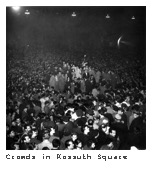
Demonstration in front of Parliament
- Many of the demonstrators make their way to Kossuth Square in front of the Hungarian Parliament
- The crowd refuses to disburse despite lights being turned out
- At 9:00 PM Imre Nagy makes a disappointing speech to the crowd
- He is ineffective at convincing the crowd to end their demonstration
Violence erupts at the Magyar Radio building
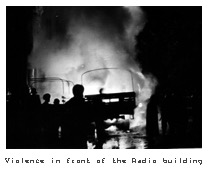
- An increasing number of demonstrators from the afternoon marches and the crowd from the Parliament gather in front of the Magyar Radio building in an effort to get the list of 16 demands broadcast
- The building is protected by armed ÁVH and police
- Weapons destined for the defenders of the building find their way into the hands demonstrators
- A speech by party 1st Secretary Gerő broadcast from the building enrages the crowd
- An armed conflict ensues. Who fired the first shots has never been clarified
- The building is besieged and finally captured by the demonstrators in early morning
Violence in front of the Radio building
- At the same time violence breaks out at the Radio building, other demonstrators gather at the giant Stalin statue at Dózsa György Street
- Consistent with one of the 16 demands, the statue is torn down
- It is dragged to a location in front of the National Theatre where it is broken to pieces
The Struggle Escalates
October 24th, 1956
The morning after

Remnants of the Stalin Statue
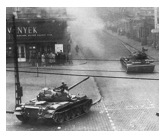
The Soviets intervene
- The decision to deploy Russian troops to quell the uprising has been made in Moscow on the previous night
- A curfew is imposed and all assemblies are banned
- In the early morning hours Soviet tanks roll into Budapest
- The fighting intensifies as the troops appear
- The tanks have been sent in without infantry support in expectation of little resistance
- With no infantry support the Soviets sustain heavy losses
- Despite many deaths on the rebel side, the major accomplishment of the day is keeping the uprising and the promise of victory alive
Nagy is nominated Prime Minister
- In an effort to placate the unrest, Imre Nagy, is nominated as Prime Minister
- His new government is not inaugurated for another three days
- At noon he makes a speech, announcing the lifting the curfew and radical new reforms
The fighting escalates
- ÁVH fires on demonstrators in Roosevelt Square
- Rebels seize large quantities of arms from Bem Square barracks
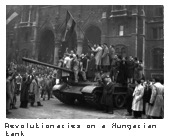
October 25th, 1956
Tanks fire on crowd in front of the Parliament
- The curfew is lifted and crowds pour into the streets
- It is obvious the Soviets are not assisting the Hungarian military, instead many of the military are fighting on the side of the rebels
- A jubilant crowd including a Hungarian tank draped with the Hungarian flag proceeds to the Kossuth Square in front of Parliament
- Soviet tanks are ordered to fire
- In the confusion Hungarian military assigned to guard Parliament become embroiled in the battle with the soviets
- A massacre results in which more than 100 lives are lost and more that 300 are injured
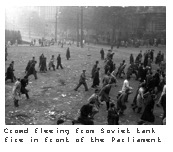
Crowd fleeing from Soviet tank fire in front of the Parliament
Gerő is dismissed
- Soviet delegates initiate his removal as party 1st Secretary
- János Kádár assumes party leadership
October 26th, 1956
Uprising spreads
- Demonstrations begin in Kecskemét claims three lives. MIG fighter planes fire shots on the Gypsy quarter.
- There are demonstrations in Békéscsaba, Eger, Esztergom, Gyöngyös, Gyõr, Gyula, Kaposvár, Komárom, Komló, Miskolc, Mohács, Nyíregyháza, Oroszlány, Pápa, Siófok, Sopron, Szeged, Székesfehérvár, Szekszárd, Szentes, Szigetvár, Szolnok, Tatabánya and Veszprém.
- Border guards at Mosonmagyaróvár fire on demonstrators, killing 52 and wounding 86.
- Soldiers fire on demonstrators from a tunnel just below the basilica in Esztergom, causing 15 deaths and at least 50 injuries.
- At Zalaegerszeg, police and party functionaries fire on the crowd, 2 died.
- There are fatalities and injuries in Nagykanizsa when volleys are fired from the party headquarters
Miskolc
- Demonstrators gather at the police station to demand the release of students arrested on the previous day
- Police and ÁVH open fire on the crowd
- Prompted by the blood shed local miners and workers storm the building massacring those they assumed were responsible for the deaths
The Promise of Victory
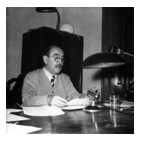
October 28th, 1956
New Government is sworn in
- Imre Nagy and his new cabinet are sworn in
- There is still much derision and suspicion as to the members
- At 2:00 PM Nagy makes a radio address, announcing:
- Soviet troops are to be withdrawn
- The ÁVH is to be dissolved
- The flag is to receive the Kossuth coat of arms
- There will be an amnesty
- He orders a ceasefire
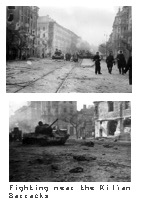
October 29th, 1956
Former Communist leaders flee to Moscow
- The former communist leaders including Ernő Gerő and András Hegedüs flee overnight to Moscow aboard Soviet planes
Heavy fighting against Soviet troops continues
- Revolutionaries assume ceasefire does not apply to Soviets
- Battles continue in the 8th and 9th districts
Mass uncertainty prevails
- In Ózd rumours circulate that disbanded ÁVH are firing at rebels
- In a frenzy, a crowd lynches three people
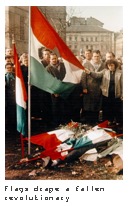
October 30th, 1956
Mob violence
- Fighting breaks out at the Hungarian Workers Party Headquarters
- Defenders indiscriminately fire at the rebels including medical staff
- A number of the defenders are lynched after the crowd storms the building
One Party System ended
- Imre Nagy announces the abolishment of the one party system
- A coalition cabinet is formed to govern the country
- Coalition parties include: Independent Smallholders, Social Democrats, and National Peasants Parties
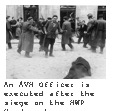
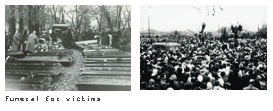

October 31st, 1956
Soviet forces withdraw
- The withdrawal of Soviet troops in Budapest is complete by noon
- This is a regrouping since existing efforts to quell the rebellion have been unsuccessful
- Further troops enter Hungary at night
Cardinal Mindszenty is released
- The Cardinal is freed from house arrest and accompanied to Budapest
Kádár flees to Moscow
- János Kádár and Ferenc Münnich negotiate with the Soviet ambassador and agree to leave for Moscow
- During a radio broadcast where Kádár affirms his support for the uprising he is already on the way to Moscow
November 1st, 1956
Hungary withdraws from Warsaw Pact
- Nagy announces Hungary’s withdrawal
- Hungary declares its neutrality in hope of securing diplomatic protection from the west
- This is seen by some historians as the factor which convinced Khrushchev to support the subsequent invasion
Where is western support?
- The Suez crisis has come to a head on the previous day with Britain and France launching attacks
- The western powers and UN are pre-occupied
- The US has concerns regarding Hungarian neutrality and fears an unpredictable response from Khrushchev if they intervene
November 2nd, 1956
Soviets plan assault
- Ferihegy Airport is surrounded by Soviet troops
- Troops begin to surround the capital
- Soviet forces establish their headquarters at Szolnok
Hungarian – Soviet negotiations
- Negotiations on Soviet troop withdrawal are initiated
- At 10:00 PM the Soviets arrest the Hungarian Military Delegation led by Pal Maléter
Counter Government established
- In Moscow the counter government headed by János Kádár and Ferenc Münnich is formed
All Hopes are Crushed

November 4th, 1956
The Soviet Assault Begins
- At 4:00 AM the Soviet attack starts
- The puppet government under Kádár does not issue it’s “call for help” to the Soviets until one hour later
- Budapest is attacked by 5 Soviet divisions
- The Soviets occupy the Defence and Interior ministries
- Parliament is surrounded
The Kádár led Hungarian Revolutionary Worker’s and Peasants Party takes over
- Imre Nagy and members of his government take refuge in the Yugoslav Embassy
- János Kádár and Ferenc Münnich return from Moscow
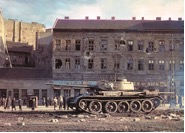
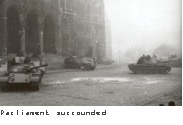
The Soviets meet fierce resistance
- The national guard fights the Soviets at Széna Square, Blaha Lujza Square and many other locations in the city
- A heavy battle ensues with the Corvin köz group on Üllői Street
- Both sides suffer severe casualties
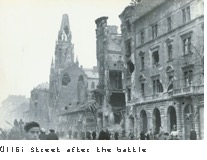
November 5th, 6th
The Battle continues but the resistance is slowly overwhelmed
- The Soviets take possession of the Magyar Radio building
- The battle on Üllői Street continues
- The National Guards at Széna Square are defeated
- Retreating guards gather in the Mecsek Hills near Pécs
- Hungarian defenders are vastly outnumbered and have no hope for victory
November 7th – 16th
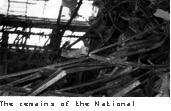
The Soviet supported government tries to appease the populace
- Kádár takes the oath of office on November 7th
- The Hungarian Revolutionary Worker’s and Peasant’s Party is declared the highest body of state administration
- The Kossuth coat of arms is legalized
- A pay increase of up to 15% is declared
The Mecsek rebels fight on
- Soviet forces continue their attack
- The rebels consolidate at Kisújbánya on November 11th but are attacked again on the 12th
- The rebels break through the Soviet encirclement and escape westward on November 16th
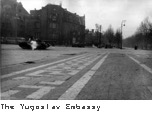
November 17th – 30th
Imre Nagy and his group are betrayed
- Kádár secretly agrees with the Soviets to have Nagy deported to Romania
- Kádár calls upon the Yugoslav embassy to hand Nagy over to the new government
- The Yugoslav government insists on maintaining the guarantee given to Nagy, but agrees to let them depart for Romania
- Against their objections, Nagy and his associates leave the embassy having received assurances of safe conduct
- They are taken to KGB headquarters and flown to Romania the next dayNovember 7th – December 30th, 1956
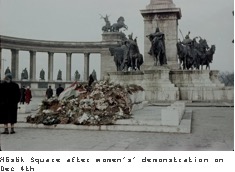
Sporadic strikes and demonstrations continue
- Worker’s councils formed in industrial areas during the revolution continue the political struggle
- Their most effective non-military weapon is: strike action
- Worker’s council wielded significant influence in local administration
- In late November special forces are created by the Kádár government to reassert control on the street
- In early December protests were organized to protest the actions of these troops
- On December 4th a demonstration of women at Hősök Square is stopped by Soviet troops and special forces
- Armed encounters with special forces continued in many cities including Miskolc, Békescsaba and Györ
- On December 9th all worker’s councils are outlawed
- After a 48 strike in protest, on December 11th and 12th, the government announced drastic new penalties and invoked Summary Justice laws
The Aftermath
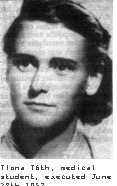
November 1956 – 1958
Reprisals
- On November 30th the Soviets call upon Kádár to begin reprisals immediately. A number of individuals are singled out
- Summary justice with immediate prosecution for certain previously determined acts such as weapons possession is imposed
- The sentences were extremely severe, often the death penalty, and were implemented immediately
- Interment camps are reopened
- The first execution related to the uprising was carried out on December 15th, 1956
- On January 12th, 1957 accelerated trials were initiated
- In total, over the subsequent years, more than 230 death sentences and several thousand imprisonments related to the events of 1956 were imposed
- Reprisals continued until a 1963 amnesty

The fate of Imre Nagy and his associates
- On February 27th, 1957 a Foreign Ministry spokesman tells Western journalists that the government does not intend to put Imre Nagy on trial
- On April 5th 1957, Kádár requests the Yugoslav government formally revoke the ‘right of asylum’ accorded to Imre Nagy and his associates
- The Imre Nagy group who have been arrested are brought back to Budapest from Romania on April 15th, 1957
- István Bibó and Zoltán Tildy, both members of the Nagy government, are also arrested
- A secret trial of Imre Nagy and his associates begins February 5–6th, 1958
- On June 9–15th, 1958 The Council of the People’s Tribunal of the Supreme Court, chaired by Ferenc Vida, concludes the secret trial of Imre Nagy and associates.
- Nagy, Miklós Gimes and Pál Maléter are sentenced to death
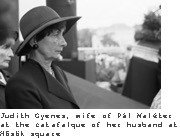
Judith Gyenes, wife of Pál Maléter at the catafalque of her husband at Hősök square - On June 16th, Nagy, Gimes and Maléter, along with the Újpest national-guard member Péter Gábor, are executed at the Budapest National Prison
- The bodies are unceremoniously buried in an unknown location
- The verdicts are publicized on June 17th
- In 1988 an emblematic funeral is held and a tomb erected for Imre Nagy in cemetery Pere Lachaise in Paris
- On June 16th, 1989, Imre Nagy, Miklós Gimes, Pál Maléter, Géza Losonczy and József Szilágy are honoured in a funeral ceremony in Hősök Square attended by tens of thousands
- On 6 July 1989 the Hungarian Supreme Court acquits Imre Nagy of the charges of high treason for which he had been executed
- Janos Kádár dies in hospital on the same day.
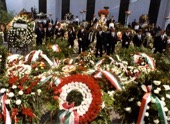
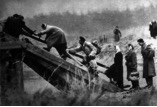
Refugees
- The number of Hungarians crossing the border into Austria during the first days of fighting were almost negligible
- On the November 4th, the day of the Soviet invasion, more than 5000 refugees had crossed into Austria by noon
- Until the close of the border in early 1957, more than 180,000 Hungarians would flee their homeland via this route
- This mass influx of refugees severely tested the limits of Austria’s new found freedom from Soviet occupation and neutrality
- International refugee organizations were hard pressed to deal with the situation
- Canada agreed to accept almost 20% of the total refugees
- More than 37,000 Hungarians fleeing the events of 1956 made Canada their new home
- 38,000 refugees came to the United States via Camp Kilmer, New Jersey
